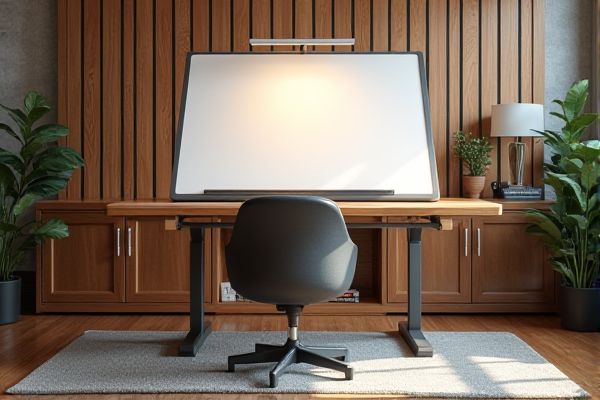
A drafting table offers adjustable height and tilt features designed to enhance precision and comfort for detailed work, unlike a standard desk which typically has a fixed, flat surface suited for general tasks. Discover how choosing between these options can impact your productivity and workspace setup by reading the full article.
Table of Comparison
| Feature | Drafting Table | Standard Desk |
|---|---|---|
| Primary Use | Technical drawing, art, design work | General office, computer work, writing |
| Surface Angle | Adjustable tilt (0deg-90deg) | Fixed flat surface |
| Ergonomics | Improves posture for detailed tasks | Standard ergonomic support for sitting tasks |
| Storage | Often includes built-in trays or compartments | Varies; usually drawers or shelves |
| Size | Larger surface area for drawings | Varies; typically smaller workspace |
| Price Range | Moderate to high | Low to moderate |
| Portability | Less portable, heavier | Generally more portable and lightweight |
| Ideal Users | Architects, artists, engineers | Students, office workers, general users |
Introduction: Drafting Table vs Standard Desk
A drafting table offers an adjustable surface ideal for artists, architects, and designers who need precise angles and ergonomic support for detailed work. Unlike standard desks, which provide a fixed, flat workspace suitable for general tasks like typing and writing, drafting tables enhance comfort and productivity through customizable tilting features. Choosing the right workspace depends on your specific needs, whether it's for creative projects demanding flexibility or routine office activities requiring stability.
Key Design Differences
Drafting tables feature an adjustable, angled surface designed to improve ergonomics for drawing and drafting tasks, unlike standard desks which have flat, fixed tops ideal for general use. The drafting table's tilt mechanism allows you to customize the angle for precise work, while standard desks prioritize horizontal workspace for computers and paperwork. Height adjustability on drafting tables often surpasses that of standard desks, enhancing comfort during detailed projects.
Ergonomics and Comfort
Drafting tables offer superior ergonomics and comfort for creative professionals by allowing adjustable height and tilt angles, reducing strain on the neck and back during prolonged use. Standard desks typically have fixed heights, which may lead to poor posture and increased discomfort when used for tasks requiring detailed visual focus. Ergonomic accessories like adjustable chairs and footrests can improve comfort at standard desks but may not match the tailored support of a drafting table's design.
Workspace Size and Flexibility
Drafting tables offer a larger, angled workspace specifically designed for detailed drawing and design tasks, providing enhanced flexibility for adjusting the surface tilt to reduce strain. Standard desks typically have a flat, fixed surface aimed at general use with less adaptability but sufficient space for computers and office supplies. Your choice depends on the need for specialized workspace adjustment versus conventional flat desk functionality.
Storage and Organization Features
Drafting tables often include built-in storage options such as adjustable trays, drawers, or shelves designed to hold art supplies and large-format papers, enhancing organization for creative projects. Standard desks typically offer more conventional storage solutions like fixed drawers and compartments ideal for office supplies and personal items, supporting efficient workspace management. Choosing between the two depends on Your need for specialized storage features aligned with Your work style and organizational preferences.
Material and Build Quality
Drafting tables typically feature durable materials such as steel frames and tempered glass or high-grade wood surfaces designed to withstand heavy use and provide precise angles for drawing. Standard desks often use particleboard or MDF with laminate finishes, which can be less robust and more susceptible to wear over time. The build quality of drafting tables emphasizes stability and adjustability to support detailed work, while standard desks prioritize general functionality and aesthetic variety.
Best Uses and Occupations
Drafting tables excel in professions requiring precise drawing, such as architects, engineers, and graphic designers, offering adjustable surfaces to improve posture and accuracy. Standard desks suit general office work, writing, and computer tasks, making them ideal for administrative roles, students, and remote workers. Your choice depends on whether you prioritize ergonomic support for detailed design work or versatile space for everyday tasks.
Cost Comparison
Drafting tables typically cost between $200 and $1,000, depending on size and features, whereas standard desks generally range from $100 to $500. Higher prices for drafting tables reflect specialized adjustable surfaces designed for architects, artists, and designers. Standard desks offer more affordable options suitable for everyday tasks without ergonomic adjustments.
Pros and Cons Overview
Drafting tables offer adjustable angles and heights, enhancing ergonomics for tasks like drawing and design, but they can be bulkier and more expensive than standard desks. Standard desks provide a stable, flat surface ideal for general office work and support a variety of equipment, yet they lack the customization features beneficial for creative or technical projects. Choosing between the two depends on specific needs such as workspace flexibility, ergonomic support, and budget constraints.
Choosing the Right Desk for Your Needs
Drafting tables offer adjustable angles and heights, making them ideal for artists, architects, and designers who require precise control over their workspace. In contrast, standard desks provide a flat surface suitable for general tasks such as computer work, writing, and office activities. Selecting the right desk depends on your specific functions, ergonomic preferences, and space constraints to enhance productivity and comfort.
 homyna.com
homyna.com